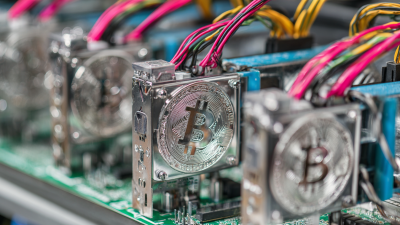Unleashing Miner Power Strategies for Maximizing Cryptocurrency Mining Efficiency
In the rapidly evolving landscape of cryptocurrency mining, understanding and harnessing Miner Power has become pivotal for maximizing efficiency and profitability. According to a recent report from the Cambridge Centre for Alternative Finance, the global Bitcoin mining ecosystem consumed approximately 130 terawatt-hours (TWh) in 2021, highlighting the significant energy demands associated with this sector. As miners strive to optimize their operations, strategies that enhance Miner Power, including advanced cooling systems and energy-efficient hardware, are increasingly essential. A study by CoinShares reveals that up to 74% of Bitcoin mining is now powered by renewable energy, indicating a shift towards sustainable practices that can further elevate efficiency. By deploying innovative techniques and best practices, miners can not only reduce operational costs but also align with eco-friendly initiatives, thus achieving a competitive edge in this high-stakes industry.

Understanding the Fundamentals of Cryptocurrency Mining Efficiency
Efficient cryptocurrency mining is essential for maximizing profitability while minimizing energy consumption. Understanding the basics of mining efficiency entails recognizing the balance between hardware capabilities and power usage. As miners employ specialized equipment to solve complex algorithms, the energy required plays a crucial role in determining overall profitability. With the emergence of new legislation aimed at regulating energy consumption related to crypto mining, it's imperative for miners to innovate and adopt strategies that reduce their carbon footprint and utility costs.
In light of the growing scrutiny over crypto mining's energy impact, miners need to stay informed about legislative changes that could influence their operations. The recent model bill indicating special protections for cryptocurrency mining raises concerns over grid stability and could lead to increased electricity rates. This evolving landscape highlights the importance of not only upgrading hardware for efficiency but also considering renewable energy sources. By embracing sustainable practices and leveraging technology, miners can enhance their operational efficiency while navigating the complexities of regulatory frameworks in the ever-changing cryptocurrency environment.

Choosing the Right Hardware for Optimal Mining Power
When it comes to maximizing cryptocurrency mining efficiency, selecting the right hardware is a crucial step for miners looking to gain an edge in an increasingly competitive market. In 2025, Bitcoin mining has seen a significant increase in difficulty, with required processing power soaring to match its rising profitability, as Bitcoin's value stabilizes above $60,000. Miners must invest in high-quality ASIC hardware to ensure they can effectively compete. Optimal hardware not only enhances hash rates but also minimizes electricity consumption, which is vital given the escalating costs associated with power.
Additionally, understanding the most profitable coins to mine is essential for maintaining profitability. With a diverse range of cryptocurrencies available in 2025, miners should analyze factors such as mining difficulty, energy costs, and market value before making decisions. Some projects may offer easier entry points with substantial returns, while others may require more investment in high-performance mining rigs. As the industry evolves, staying informed about the latest mining software and strategies will further enhance efficiency and profits, allowing miners to remain relevant in the fast-paced crypto landscape.
Implementing Effective Cooling Solutions to Boost Mining Performance
Effective cooling solutions are crucial for maximizing the performance of cryptocurrency mining operations. Mining hardware generates substantial heat during operation, which can lead to thermal throttling if not managed properly. Investing in advanced cooling systems can maintain optimal operating temperatures, thus ensuring that mining rigs run efficiently. Techniques such as immersion cooling and liquid cooling systems are becoming increasingly popular, as they not only reduce operating temperatures but also enhance energy efficiency. By keeping hardware cool, miners can significantly improve their hash rates while extending the lifespan of their equipment.
Furthermore, proper ventilation and airflow management play vital roles in mining performance. Utilizing fans, air ducts, and strategic placement of mining rigs can optimize airflow and dissipate heat effectively. Additionally, incorporating temperature monitoring systems allows miners to track the performance of cooling solutions in real-time, enabling timely adjustments when necessary. Adopting these cooling strategies not only enhances mining efficiency but also contributes to lower energy consumption, making cryptocurrency mining a more sustainable venture. By prioritizing effective cooling solutions, miners can unleash their hardware's full potential and achieve greater profitability.
Utilizing Advanced Software for Enhanced Hash Rate Management
In the rapidly evolving landscape of cryptocurrency mining, the implementation of advanced software for enhanced hash rate management is crucial for maximizing operational efficiency. By employing sophisticated analytics, mining companies can not only fine-tune their strategies but also effectively forecast short-term price movements. This capability allows miners to optimize their trading decisions, aligning their operations with market dynamics and potentially increasing earnings before interest and taxes (EBIT).
Moreover, the integration of automation, artificial intelligence (AI), and Internet of Things (IoT) technologies can significantly improve mining efficiency and safety. By leveraging AI for predictive analysis and IoT for real-time monitoring, mining operations can minimize risks and enhance productivity. In addition, restructuring supply chains to prioritize resilience can shield mining companies from disruptions, ensuring a steady flow of resources and further bolstering their profitability. As the sector continues to innovate, those who adeptly harness advanced software and analytics will likely dominate the competitive landscape of cryptocurrency mining.

Strategies for Reducing Electricity Costs in Mining Operations
Reducing electricity costs is crucial for maximizing the efficiency of cryptocurrency mining operations. In 2023, more than 70% of a miner's total operational costs are attributed to electricity usage, according to the Cambridge Centre for Alternative Finance. As energy prices fluctuate globally, miners must adopt strategic measures to minimize these expenses while maintaining profitability.
One effective strategy involves optimizing hardware performance. Miners should upgrade to energy-efficient models, as newer ASIC miners can yield significantly better hash rates per watt. For instance, models like the Antminer S19 Pro offer up to 29.5 J/TH, compared to older models that may consume upwards of 50 J/TH. Additionally, utilizing renewable energy sources such as solar or wind can drastically cut costs and provide a sustainable edge in competitive markets.
**Tips**: Consider implementing energy management systems to monitor and adjust power usage dynamically. Furthermore, joining mining pools can spread electricity costs across various participants, enabling miners to share resources for maximum efficiency. Staying informed about local energy tariffs and exploring state incentives for green energy solutions can further enhance cost savings in mining operations.
Maximizing Cryptocurrency Mining Efficiency
Related Posts
-

The Ultimate Guide to Unlocking the Potential of Miner Power for Your Business
-

Top 5 Asic Crypto Miner Choices for 2023 with Highest Hash Rates and Best ROI
-

How to Choose the Right Crypto Miner for Your Investment Needs
-

Exploring the Advantages of Cryptocurrency Mining Containers for Optimal Efficiency
-

Ultimate Guide to Selecting the Best Btc Asic Miner for Your Cryptocurrency Needs
-

How to Navigate the 2025 Trends in Cryptocurrency Mining Container Technology
